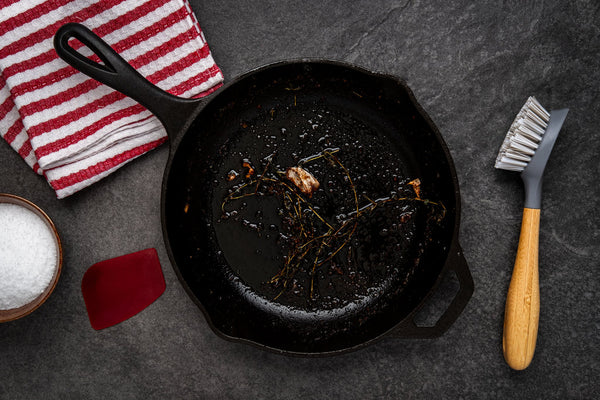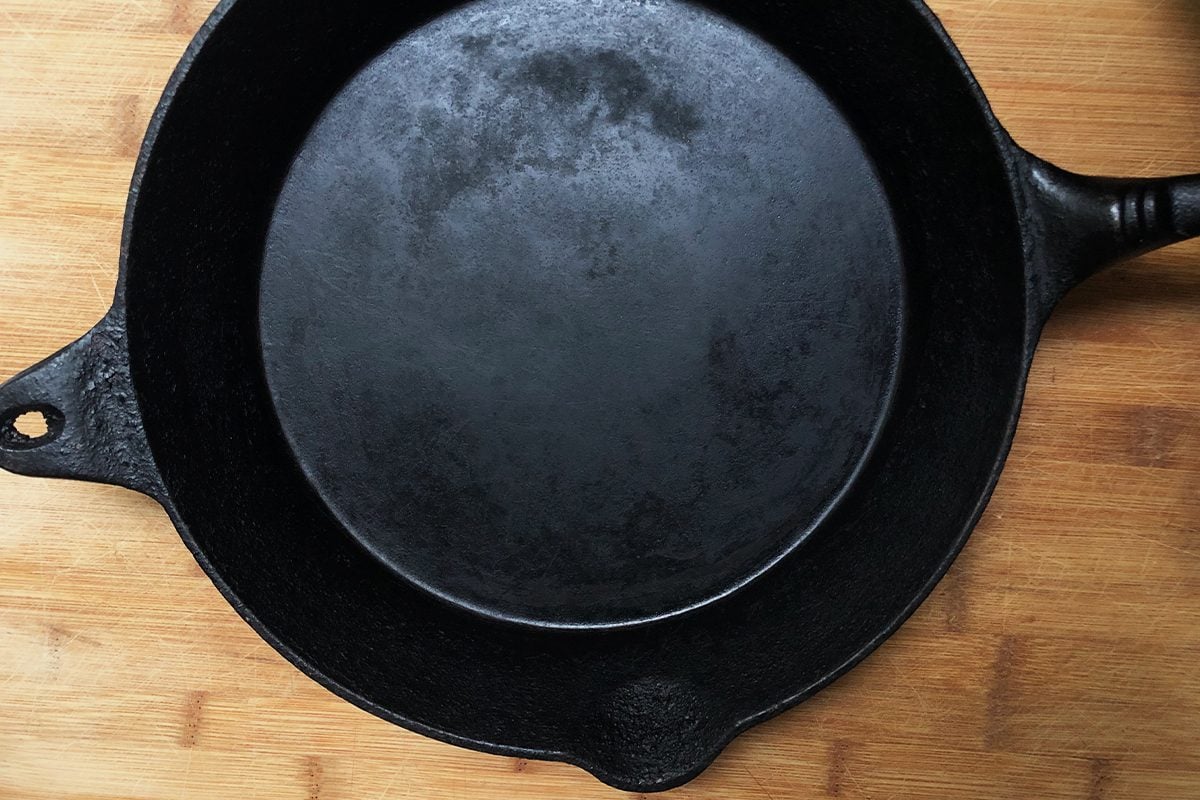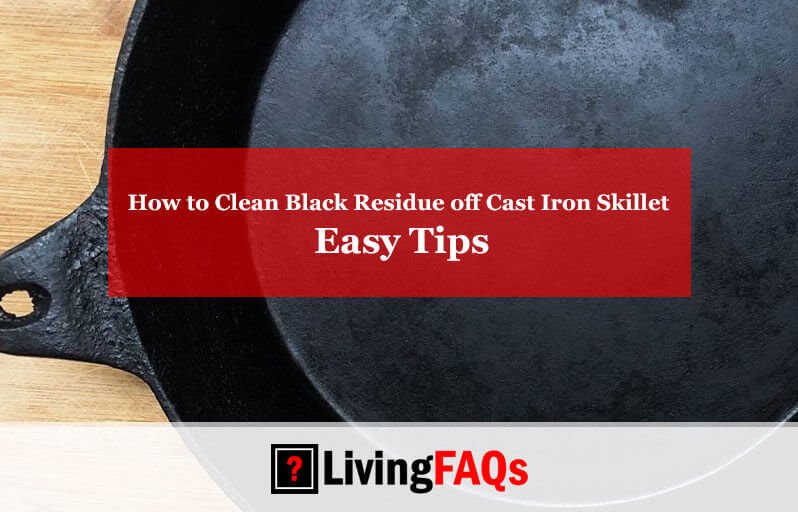To clean black residue off a cast iron skillet, scrub it with a mixture of coarse salt and water. Then, rinse and dry it thoroughly to prevent rust.
Cast iron cookware is prized for its heat retention and durability, becoming a staple in kitchens worldwide. Over time, these skillets can accumulate black residue, a combination of burnt food particles, seasoning build-up, and oil polymerization. A well-maintained cast iron skillet not only improves with age but also enhances the flavors of your food.
Regular cleaning ensures your skillet remains non-stick and free from harmful bacteria. This introductory guide will provide essential tips for keeping your cast iron skillet in pristine condition, ensuring it lasts for generations. Embracing the proper cleaning techniques can elevate your cooking and preserve the quality of your cookware.

Credit: unocasa.com
Introduction To Cast Iron Care
Cast iron skillets are treasures in the kitchen. Their ability to retain heat makes them perfect for searing and frying. Yet, their maintenance differs from other cookware. Proper care ensures a long-lasting, non-stick surface. This guide will help you understand the special attention needed for your cast iron skillet.
Why Cast Iron Skillets Need Special Attention
These skillets are not like other pans. They are made of iron, which can rust. They also have a seasoning layer. This layer is a protective coating. It comes from baked-on oils. This seasoning gives cast iron its non-stick quality. Without proper care, this layer can wear away. This would lead to rust and food sticking.
- Keep them dry: Water is the enemy of iron. Dry your skillet right away.
- Season regularly: This means baking oil onto the skillet. It protects and maintains the surface.
- Avoid harsh soaps: They can strip the seasoning. Use gentle cleaners instead.
Common Challenges With Maintaining Cast Iron
Maintaining cast iron can be tricky. Users often face a few challenges.
| Challenge | Solution |
|---|---|
| Rust formation | Scrub off rust, re-season the skillet. |
| Sticky residue | Clean with salt and oil, heat, then wipe clean. |
| Dull appearance | Re-season to restore shine and non-stick surface. |
By knowing these tips, you can keep your skillet in great shape. Remember, a well-maintained skillet can last a lifetime.

Credit: www.reddit.com
Identifying Black Residue On Cast Iron
Let’s talk about Identifying Black Residue on Cast Iron. Spotting black residue on your beloved cast iron skillet can be worrying. It’s important to know what it is, why it happens, and if it’s safe. This will help keep your skillet in top shape for years of cooking joy.
What Causes Black Residue?
The black residue on cast iron skillets often comes from two sources:
- Stuck-on food: Bits of food can burn and stick.
- Seasoning build-up: Too much oil can form a sticky layer.
Cleaning your skillet properly after each use prevents this issue.
Is Black Residue Harmful?
Many wonder if this black stuff is bad for health. The short answer is no. It’s mostly harmless carbonized food. Yet, it can affect taste and skillet performance. Eating a bit won’t hurt, but it’s best to clean it off for the best cooking results.
Preventive Measures
Keeping your cast iron skillet clean ensures a long-lasting cookware companion. But, it’s not just about cleaning after use. Preventive measures can stop black residue from building up. Let’s explore how to keep your skillet in top shape.
Seasoning Your Cast Iron Skillet
Seasoning is a shield for your skillet. It prevents rust and creates a non-stick surface. Follow these steps:
- Wash the skillet with warm, soapy water.
- Dry it thoroughly with a clean cloth.
- Apply a thin layer of cooking oil all over the skillet.
- Place it upside down in a preheated oven at 375°F for an hour.
- Let it cool in the oven before taking it out.
Repeat this process a few times a year. It keeps the skillet in prime condition.
Best Practices For Daily Use
Everyday care is crucial. It makes cleaning easier. Here are best practices:
- Cook over low or medium heat to avoid burns.
- Clean while the skillet is still warm.
- Avoid soaking the skillet in water.
- Use a scraper for stuck-on food.
- Dry the skillet immediately after washing.
- Rub a light coat of oil after each wash.
Follow these tips for a clean, ready-to-use skillet every time.
Cleaning Tools And Materials
When it comes to maintaining your cast iron skillet, using the right tools and materials is crucial. The goal is to remove the black residue without damaging the skillet’s seasoned surface. Below, find the key items you’ll need to keep your skillet in pristine condition.
Choosing The Right Cleaning Tools
Start with gentle, non-abrasive tools:
- Stiff brush: A brush with rigid bristles tackles residue without scratching.
- Scouring pad: Opt for non-metal versions to avoid damage.
- Plastic scraper: This tool removes stuck food bits easily.
- Chainmail scrubber: Stainless steel mesh cleans without harming the seasoning.
Safe And Effective Cleaning Agents
Choose mild, natural cleaners:
- Kosher salt: Salt acts as a gentle abrasive to scrub away residue.
- Water: Warm water rinses away loose particles.
- Vinegar mix: A solution of equal parts water and vinegar helps with rust.
- Oil: A light coat of cooking oil protects the skillet after cleaning.
Remember, avoid harsh chemicals and soaps as they can strip the skillet’s seasoning. Use these recommended tools and agents to keep your cast iron skillet clean, safe, and functional for many years.
Step-by-step Cleaning Process
Let’s dive into the step-by-step cleaning process for your cast iron skillet. This guide ensures your skillet stays in top shape, ready for your next cooking adventure.
Removing Food Particles
Start by removing loose food particles. Use a paper towel or soft brush. This step is easy and quick.
- Let the skillet cool down.
- Wipe with a paper towel.
- Use a brush for stuck particles.
Dealing With Stubborn Residue
Sometimes, food sticks and won’t come off easily. Don’t worry. Follow these steps:
- Heat skillet with a little water.
- Let it simmer for a minute.
- Scrub gently with a stiff brush.
- Rinse with warm water.
- Dry completely.
Note: Avoid soap and steel wool. They can harm the skillet.
Rinsing And Drying Techniques
After scrubbing your cast iron skillet, the next steps are crucial. You must rinse and dry it properly. This prevents rust and maintains the skillet’s seasoning. Let’s dive into rinsing and drying techniques that keep your skillet in great shape.
Proper Rinsing For A Residue-free Surface
Cast iron skillets need careful rinsing to avoid residue build-up. Use warm water to rinse the skillet. Avoid using soap as it can strip the skillet’s seasoning. Instead, use a soft brush or sponge to remove any remaining food particles. Make sure to reach all the nooks and crannies.
- Turn on warm water
- Use soft brush or sponge
- Gently scrub the skillet
- Rinse thoroughly
- Check for any leftover residue
Drying Methods To Prevent Rust
Moisture is the enemy of cast iron. It leads to rust. Therefore, drying your skillet immediately after rinsing is vital. Use a clean, dry towel to wipe the surface. Then, place the skillet on the stove over low heat. This ensures complete evaporation of any remaining water.
- Wipe with a dry towel
- Heat on stove
- Evaporate remaining water
Once your skillet is dry, apply a light coat of oil. Use a paper towel to spread the oil. This protects the surface and keeps it non-stick. Store your skillet in a dry place until its next use.
| Step | Action | Purpose |
|---|---|---|
| 1 | Wipe dry | Remove moisture |
| 2 | Heat on stove | Evaporate water |
| 3 | Apply oil | Protect surface |
Re-seasoning After Cleaning
Re-seasoning After Cleaning is a vital step in maintaining your cast iron skillet. It involves coating the skillet with oil and baking it. This process creates a non-stick surface. It also prevents rust and ensures longevity.
The Importance Of Re-seasoning
Re-seasoning restores the skillet’s protective layer. This layer is known as the “seasoning.” It is what makes your skillet non-stick. Re-seasoning also prevents moisture. Moisture can lead to rust. Your skillet needs regular care to perform well.
How To Properly Season Your Skillet
To season your skillet, follow these steps:
- Preheat your oven to 375°F (190°C).
- Wash the skillet with warm water. Dry it thoroughly.
- Apply a thin layer of vegetable oil. Cover the skillet’s entire surface.
- Place the skillet upside down in the oven. This prevents pooling oil.
- Bake for one hour. Let it cool in the oven.
Repeat this process up to three times. This builds up a strong seasoning. Your skillet is now ready for use. Enjoy cooking with a newly seasoned surface.
Troubleshooting Common Issues
Cleaning a cast iron skillet can sometimes leave a puzzling black residue. This guide will help you tackle those stubborn spots and maintain your cookware’s condition.
When Residue Persists
Cleaning a cast iron skillet seems straightforward, but persistent residue can be frustrating. If a normal wash doesn’t do the trick, consider these steps:
- Boil water in the pan to loosen residue.
- Use a paste of coarse salt and water to scrub gently.
- Rinse and dry the skillet immediately after.
- Apply a thin layer of oil to protect the surface.
Avoiding Common Cleaning Mistakes
Proper care ensures a long life for cast iron skillets. Avoid these common cleaning errors:
| Mistake | Solution |
|---|---|
| Using harsh detergents | Opt for gentle soap or just hot water. |
| Scrubbing with metal pads | Choose non-abrasive scrubbers. |
| Soaking in water | Wash and dry immediately. |
| Forgetting to oil after washing | Always season the skillet lightly with oil. |
Maintaining Your Cast Iron Skillet Long-term
Keeping a cast iron skillet in prime condition requires regular attention. This ensures both its performance and longevity. Learn how to maintain your skillet and keep it ready for generations of cooking.
Regular Maintenance Schedule
Care for your cast iron after each use. Follow these steps for a lasting skillet:
- Clean promptly while warm.
- Dry thoroughly to prevent rust.
- Oil it lightly to maintain seasoning.
Perform deep cleans and reseasoning as needed. This avoids tough buildup.
Storing Your Cast Iron Skillet
Proper storage is key to avoid damage. Keep these points in mind:
- Store in a dry place.
- Use a paper towel to separate stacked pans.
- Avoid airtight lids that trap moisture.
Follow these tips to ensure your skillet is always ready to use.
Conclusion: Enjoying Your Restored Cast Iron Skillet
Congratulations on cleaning your cast iron skillet! Now, it’s time to enjoy the fruits of your labor. A well-maintained cast iron skillet not only enhances your cooking experience but also contributes to the longevity of this versatile kitchen tool. Let’s dive into the benefits and get inspired for your next culinary adventure.
The Benefits Of A Well-maintained Cast Iron Skillet
- Better flavor: Clean cast iron gives your food a rich taste.
- Non-stick surface: Regular maintenance keeps it non-stick.
- Even heating: A smooth skillet heats food evenly.
- Lasts longer: Your skillet can last for generations.
Inspiration For Your Next Cast Iron Cooking Adventure
Now that your skillet shines, why not try something new? Here are some ideas:
- Skillet pizza: Get a crispy crust right at home.
- Cornbread: For a golden, crunchy edge.
- Seared steak: Achieve the perfect sear.
- Fried vegetables: For a quick, tasty side.
Each dish brings out the best in your cast iron skillet. So, grab your apron and start cooking!

Credit: www.tasteofhome.com
Frequently Asked Questions
Why Does Cast Iron Skillet Get Black Residue?
Cast iron skillets can accumulate black residue due to burnt food particles, seasoning build-up, or rust that has been converted to a black oxide.
What’s The Best Way To Clean Black Residue?
The best way to clean black residue is to scrub the skillet with a mixture of coarse salt and water, then rinse and dry it thoroughly.
Can I Use Soap On Cast Iron Skillet?
Mild soap can be used on a well-seasoned cast iron skillet, but it’s not necessary for routine cleaning and can strip seasoning if overused.
Is Vinegar Effective For Cast Iron Cleaning?
Vinegar can help remove rust and can be used in a solution with water to soak the skillet briefly before thorough rinsing and re-seasoning.
How Often Should I Re-season Cast Iron?
Re-season your cast iron skillet whenever it looks dull or after cleaning that has removed some of the seasoning layers, typically a few times a year.
Conclusion
Cleaning your cast iron skillet of black residue might seem daunting, but it’s quite manageable with the right approach. Regular maintenance ensures your cookware’s longevity and performance. Embrace these simple steps, and enjoy the benefits of a well-kept cast iron skillet in your culinary adventures.
Remember, a clean skillet equals happier, healthier cooking.

